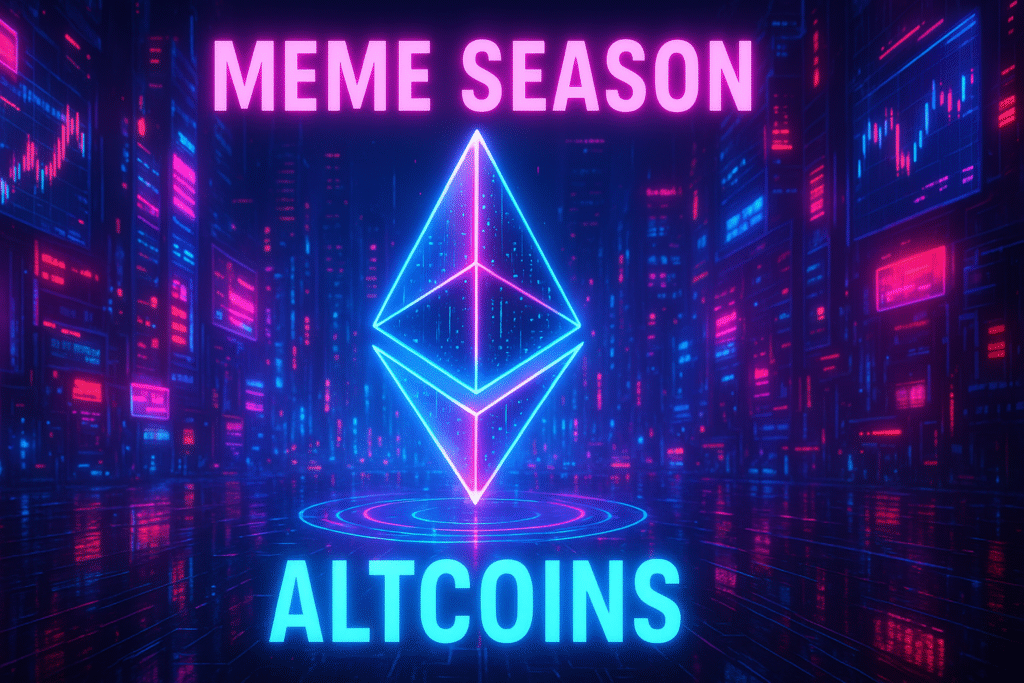Is your portfolio ready to surf the next digital wave? As the cryptocurrency market matures, we’re witnessing cyclical patterns emerge, and none are as electrifyingly volatile and potentially rewarding as the Meme Season. But what if you could harness the raw energy of this phenomenon, not just ride it? What if you could predict the shifts and capitalize on the explosive growth opportunities that define the Meme coin rally? This isn’t just about luck; it’s about understanding the underlying mechanics and employing smart strategies.
The current crypto landscape, while often dominated by the narrative of Bitcoin and Ethereum, is increasingly characterized by the rapid ascent of altcoins, particularly those with a meme-driven ethos. Many investors are looking beyond the giants, seeking the next 10x or even 100x returns that the altcoin market, especially during a meme season, can offer. But navigating this dynamic space requires more than just a keen eye for internet jokes; it demands data-driven analysis, a robust understanding of tokenomics, and a keen awareness of the inherent risks. This article will equip you with the top 7 secrets to unlock significant gains during these exhilarating periods, transforming your approach from speculative dabbling to strategic accumulation.
Crypto Market Overview
The cryptocurrency market is a kaleidoscope of innovation and sentiment, constantly shifting and recalibrating. As of late, we’ve seen a noticeable resurgence of interest in altcoins, often catalyzed by broader market uptrends or specific project developments. While Bitcoin dominance remains a key indicator, the correlation between Bitcoin’s movements and altcoin performance is not always linear. We’re seeing increased activity in sectors like decentralized finance (DeFi), non-fungible tokens (NFTs), and, of course, the ever-present meme coin space.
Key market indicators such as the total crypto market cap, Bitcoin dominance percentage, and the performance of major altcoins like Ethereum, Solana, and Cardano provide a baseline. However, the real opportunity for exponential gains often lies in the smaller-cap altcoins, many of which fall under the “meme coin” umbrella or are inspired by trending cultural phenomena. These assets, while highly speculative, can experience parabolic price increases during periods of intense social media hype and collective investor enthusiasm. Understanding these micro and macro trends is crucial for identifying potential opportunities before they become widely recognized.
The recent performance of meme coins, for instance, has been a stark reminder of their potential impact on the broader altcoin market. Projects that started as lighthearted internet jokes have evolved into significant digital assets with substantial market capitalizations, often driven by community support and viral marketing campaigns. This trend highlights a critical shift in how digital assets are perceived and adopted, emphasizing the power of community and narrative in driving value.

The Core Concept: How Meme Coins Actually Work
The allure of meme coins is undeniable, but the question remains: what truly drives their value, and how can one effectively participate?
What Are Altcoins / Meme Coins / Airdrops?
Let’s break down these terms to understand their place in the crypto ecosystem.
Altcoins: This is a broad category encompassing all cryptocurrencies other than Bitcoin. It includes everything from established giants like Ethereum and Solana to smaller, more niche projects. Altcoins often aim to improve upon Bitcoin’s technology, offer new use cases, or explore different consensus mechanisms. They represent the vast majority of the cryptocurrency market by volume and innovation.
Meme Coins: These are a sub-category of altcoins that, in their genesis, are often inspired by internet memes, jokes, or popular culture. While many start as a humorous endeavor, some, like Dogecoin and Shiba Inu, have evolved to build robust communities, develop utility, and achieve significant market capitalizations. Their value is heavily influenced by social media sentiment, community engagement, and virality, often with less emphasis on underlying technological innovation compared to other altcoins.
Airdrops: An airdrop is a marketing strategy used by cryptocurrency projects to distribute a certain number of free tokens to various wallet addresses. This is typically done to promote a new coin, increase awareness of an existing one, or reward existing holders of a particular cryptocurrency. Airdrops can be a way for new users to acquire crypto assets without investment, and for projects to build a wider, more engaged user base.
The key differentiator for meme coins is their origin and primary driver of value: community and viral spread. While traditional altcoins might focus on solving specific technological problems or offering unique utility from the outset, meme coins often leverage cultural moments and online virality to gain traction. This doesn’t negate their potential for profit; it simply means the analysis and strategies employed need to be different.
Key Components & Technologies
While meme coins might appear simple, they are built upon foundational blockchain technology, just like their more serious altcoin counterparts.
Blockchain Technology: At their core, meme coins operate on decentralized ledger technology, most commonly built on existing blockchain platforms like Ethereum (using the ERC-20 standard) or Binance Smart Chain (BSC) (using the BEP-20 standard). This provides a secure, transparent, and immutable record of transactions. The underlying blockchain ensures the integrity of the token supply and ownership.
Smart Contracts: Meme coins are typically created using smart contracts, which are self-executing contracts with the terms of the agreement directly written into code. These contracts govern the creation, distribution, and transfer of the tokens on the blockchain.
Decentralized Finance (DeFi) Integration: Many newer meme coins are attempting to differentiate themselves by integrating DeFi functionalities. This can include features like staking for rewards, yield farming, or liquidity provision on decentralized exchanges (DEXs). This integration adds a layer of utility, moving them beyond pure speculative assets.
Community Governance (DAOs): Some meme coin projects are experimenting with Decentralized Autonomous Organizations (DAOs) for governance. This allows token holders to vote on proposals related to the project’s future development, marketing, and treasury management, fostering a sense of ownership and collective direction.
Understanding these technical underpinnings is vital. Even in a meme-driven market, the robustness of the underlying technology and the utility it enables can be a significant factor in a token’s long-term viability and potential for sustained growth.
The Data-Driven Perspective
While sentiment and hype are powerful forces in the meme coin market, a data-driven approach is paramount for sustained success. Blindly chasing the next viral token is a recipe for disaster; understanding the data allows for informed decision-making.
Market Data & Trends
Social Media Volume & Sentiment Analysis: Tools analyzing social media mentions, sentiment (positive/negative), and trending hashtags related to specific coins can provide early indicators of growing interest. Platforms like Twitter, Reddit, and Telegram are crucial for gauging community momentum. An increasing number of positive mentions and active discussions often precede significant price movements. For example, tracking the daily tweet volume for a meme coin and the percentage of positive sentiment can highlight potential breakout candidates.
Trading Volume & Liquidity: High trading volumes and deep liquidity on decentralized exchanges (DEXs) are indicative of a healthy and actively traded asset. Spotting tokens with increasing trading volume, particularly when breaking out of consolidation phases, can signal accumulating interest from traders. Low liquidity can lead to extreme price volatility and difficulty exiting positions. Data from DEX aggregators like CoinMarketCap and CoinGecko is essential here.
On-Chain Data: While more advanced, analyzing on-chain data can reveal valuable insights. This includes the number of active wallets holding a specific token, the distribution of tokens (are a few wallets holding a disproportionate amount, indicating potential manipulation?), and transaction activity. An increasing number of unique wallet addresses accumulating a token, especially when price is stable or gradually increasing, can be a bullish sign.
Correlations with Major Cryptocurrencies: Observing how altcoins, particularly meme coins, react to major market movements (e.g., Bitcoin’s price action) can inform strategy. Often, altcoins experience amplified gains when Bitcoin rallies and exacerbated losses when Bitcoin corrects. Understanding these correlations helps in timing entries and exits.
Tokenomics & Market Health
Tokenomics refers to the economic design of a cryptocurrency, encompassing its supply, distribution, utility, and inflationary/deflationary mechanisms.
Total Supply & Circulating Supply: A fixed or caped total supply, especially when combined with mechanisms that reduce circulating supply (like token burns), can create scarcity and drive up value if demand increases. Conversely, an uncapped supply or high inflation rate can put downward pressure on prices. For meme coins, a large circulating supply requires substantial demand to move prices significantly.
Token Distribution & Whales: Analyze how tokens are distributed. If a large percentage of tokens are held by a few “whales” (large holders), they have the power to significantly influence the price through large buy or sell orders. A more decentralized distribution among many holders is generally considered healthier. Tracking the number of wallets holding over a certain threshold (e.g., 1% of total supply) can reveal this.
Utility & Use Case: While many meme coins initially lack utility, successful ones often develop use cases. This could be anything from being used for payments within a specific ecosystem, powering a game, or offering governance rights. The presence of a clear and growing utility can provide a fundamental basis for value beyond pure speculation. Projects that are actively developing and delivering on their roadmap, even if it’s a meme-based ecosystem, tend to have more sustainable growth.
Staking & Yield Opportunities: The ability to stake a meme coin to earn rewards can incentivize holding and reduce selling pressure. Analyzing the Annual Percentage Yield (APY) for staking, as well as the mechanisms for reward distribution, is crucial. High APYs can attract new investors but might also indicate inflationary pressures if not managed carefully.
By combining these data points, investors can move beyond the hype and identify meme coins with a stronger foundation for growth and a more favorable risk-reward profile.
Risks, Challenges & Competition
The vibrant potential of the meme coin market comes hand-in-hand with significant risks and a highly competitive landscape.
Risks of Altcoins and Meme Coins
Extreme Volatility: Meme coins are notorious for their wild price swings. They can experience astronomical gains in a short period, only to crash just as rapidly. This volatility is amplified by their reliance on sentiment and social media trends, which can change on a dime. For instance, a popular meme coin could drop 50% in a day if a prominent influencer shifts their attention or negative news breaks.
Market Manipulation & Pump-and-Dump Schemes: The speculative nature of meme coins makes them susceptible to pump-and-dump schemes, where coordinated groups artificially inflate the price of a token and then sell off their holdings at a profit, leaving other investors with significant losses. The anonymity and decentralized nature of crypto can make it difficult to identify and prosecute such activities.
Lack of Intrinsic Value & Utility: Many meme coins are launched with little to no underlying technology, utility, or real-world application. Their value is derived almost entirely from speculative demand and community hype. When the hype fades, the price can evaporate, leaving holders with worthless tokens.
Security Vulnerabilities: As with any crypto project, meme coins can be vulnerable to smart contract exploits, rug pulls (where developers abandon a project and abscond with investor funds), and phishing attacks. Thorough due diligence on the project team, the code, and the security audits is crucial.
Regulatory Uncertainty: The regulatory landscape for cryptocurrencies, and particularly for meme coins, is still evolving. Governments worldwide are grappling with how to classify and regulate these digital assets, leading to potential future restrictions or crackdowns that could impact their value and legality.
How Does Meme Season Actually Stack Up Against Competitors?
When we talk about “competitors” in the context of Meme Season, we’re primarily looking at how this phenomenon compares to investing in more established altcoins or even blue-chip cryptocurrencies like Bitcoin and Ethereum.
| Feature | Meme Coins (during Meme Season) | Established Altcoins (e.g., Ethereum, Solana) |
|---|---|---|
| Potential ROI | Extremely High (100x+ possible) | Moderate to High (significantly less volatile than meme coins) |
| Risk Level | Very High (prone to extreme volatility and rug pulls) | High (but generally more stable than meme coins) |
| Underlying Tech | Often basic, sometimes innovative, lacks robust utility initially | Advanced, diverse use cases (DeFi, NFTs, dApps) |
| Value Driver | Community, hype, social media trends, virality | Technological innovation, real-world adoption, utility |
| Investment Horizon | Short-term, speculative | Medium to Long-term, strategic |
| Entry Barrier | Low (accessible to newcomers) | Moderate (requires understanding blockchain concepts) |
| Market Cap | Highly variable, can be very low | Generally larger, more established |
| Community | Dedicated, often meme-focused, highly engaged | Developers, users, investors, often utility-driven |
As you can see, meme coins during their peak season offer the potential for astronomical returns, a far cry from traditional altcoins. However, this comes at the cost of significantly amplified risk. Established altcoins provide a more stable investment profile, driven by utility and technological advancement, offering more predictable (though often lower) growth. For a diversified strategy, understanding where meme coins fit in – as high-risk, high-reward plays – is key.
The Future Outlook
The trajectory of altcoins and the recurring phenomenon of Meme Season are intrinsically linked to the broader evolution of the cryptocurrency market and digital culture. Predicting the future with certainty is impossible, but analyzing current trends offers valuable insights.
What’s Next for Altcoins / Meme Coins / Airdrops?
Maturation of Meme Coin Utility: While many meme coins currently rely on speculation, a trend toward integrating actual utility is likely to continue. Projects that can successfully build ecosystems, offer tangible use cases (e.g., gaming, metaverse integration, loyalty programs), and foster genuine community engagement beyond fleeting viral trends will likely see more sustainable growth. This could involve the development of their own blockchains, advanced DeFi features, or integration into popular decentralized applications.
Increased Sophistication of Airdrops: Airdrops are evolving from simple token giveaways to more strategic engagement tools. Future airdrops may be more targeted, rewarding specific user behaviors, participation in testnets, or contributions to community development. Expect to see more utility-based airdrops that deliver valuable tokens in exchange for genuine ecosystem participation, rather than just holding a certain coin.
Regulatory Clarity and Impact: As governments worldwide continue to define their stance on digital assets, regulatory clarity will inevitably impact altcoins and meme coins. While stricter regulations could curb some of the more speculative excesses, they could also legitimize projects with sound fundamentals and clearer utility, fostering greater investor confidence. The ability of projects to adapt and comply with evolving regulatory frameworks will be a significant factor in their long-term survival.
The Blurring Lines of Meme Culture and Technology: The fusion of internet culture and blockchain technology is likely to deepen. We may see more innovative cross-pollination, where successful memes evolve into functional platforms, and robust technological projects adopt meme-like marketing strategies to build massive communities. The key will be distinguishing between genuine innovation disguised as a meme and pure speculative vehicles.
The Role of Influencers and Community Validators: In the evolving landscape, the influence of key opinion leaders (KOLs) and community validators will remain significant. However, discerning genuine endorsements from paid promotions will become even more critical. A focus on project fundamentals and community sentiment over singular influencer pronouncements will be a hallmark of more successful investing.
The future of meme coins and altcoins is bright with potential, but it demands adaptation, continuous learning, and a commitment to fundamental analysis, even within the hyper-growth environments of meme seasons. By staying informed about technological advancements, regulatory shifts, and evolving community dynamics, you can better position yourself to navigate this exciting corner of the crypto market.
Conclusion
Navigating the exhilarating, and often unpredictable, terrain of Meme Season presents a unique set of opportunities and challenges for altcoin investors. We’ve explored how these digital assets, born from internet culture, can offer parabolic gains but are inherently volatile and subject to rapid shifts in sentiment. The key to unlocking consistent gains lies not in blindly chasing the next viral sensation, but in adopting a data-driven, strategic approach.
We’ve dissected the essential elements: understanding the core technology and mechanics of meme coins, analyzing market data and social sentiment for early indicators, and critically evaluating tokenomics for sustainable value. We also delved into the crucial risks, from extreme volatility and market manipulation to the importance of differentiating between hype and genuine utility. By comparing meme coins to more established altcoins, we highlighted the distinct risk-reward profiles, underscoring the need for a balanced investment strategy. The future outlook suggests a trajectory towards greater utility and potential regulatory clarity, rewarding projects that blend community engagement with sound innovation.
Remember, success in Meme Season isn’t just about luck; it’s about informed decisions, diligent research, and a risk management strategy that aligns with your financial goals.
What are your thoughts on the current Meme coin rally? Have you successfully navigated previous meme seasons? Share your experiences and insights in the comments below! For more in-depth analysis on specific altcoins, DeFi strategies, or cryptocurrency market trends, be sure to subscribe to our newsletter and explore our related articles.
FAQs
Q1: What is a “Meme Season” in cryptocurrency?
A “Meme Season” refers to a period in the cryptocurrency market characterized by a significant surge in interest and price appreciation for meme coins. This is typically driven by widespread social media hype, community engagement, and viral marketing, leading to rapid and often speculative growth for these digital assets.
Q2: Are meme coins a good investment?
Meme coins can offer high returns, but they are also extremely speculative and carry significant risks, including extreme volatility, potential for market manipulation, and a lack of intrinsic value or utility in many cases. They are best treated as high-risk investments, and it’s crucial to only invest what you can afford to lose.
Q3: How can I find potential meme coins to invest in during a meme season?
Identifying potential meme coins involves monitoring social media platforms (Twitter, Reddit, Telegram), tracking trending crypto hashtags, analyzing trading volumes on decentralized exchanges, and looking for projects with strong community engagement and clear (even if nascent) utility. Always conduct thorough due diligence.
Q4: What are the biggest risks associated with meme coins?
The biggest risks include extreme price volatility, susceptibility to pump-and-dump schemes, lack of fundamental value or utility, potential security vulnerabilities (like rug pulls), and regulatory uncertainty.
Q5: How do airdrops work, and can they be profitable?
Airdrops are free distributions of tokens by crypto projects to build awareness and grow their user base. They can be profitable if the airdropped tokens increase in value after distribution. However, participation often requires meeting certain criteria, and the value of airdropped tokens can be highly unpredictable.
Q6: Should I invest in Bitcoin or altcoins during a meme season?
During a meme season, altcoins, particularly meme coins, may experience amplified gains. However, Bitcoin and established altcoins like Ethereum often serve as the market’s backbone. A diversified strategy that includes a mix of stable assets and speculative plays like meme coins, based on your risk tolerance, is generally recommended.
Q7: How do I differentiate between a legitimate altcoin and a pump-and-dump meme coin?
Look for projects with a clear roadmap, active development, a transparent team, solid tokenomics, and ideally, some form of utility or problem-solving capability. Legitimate projects are usually transparent about their goals and technology, whereas pump-and-dump schemes often rely solely on hype and have little substance.







100x Gems: Unlock Top Altcoin & Meme Coin Secrets - Daily Coine
[…] for the Next Big Win? How to Find 100x […]